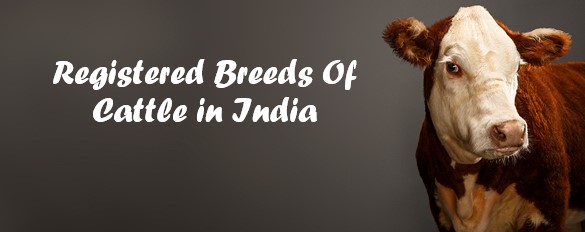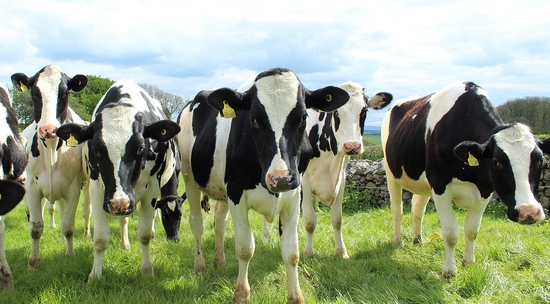
What is Cow ?
Cow in short
Scientific Name : Bos Taurus
Color : Brown, Black, White
Skin Type : Leather
Top Speed : 25 mph
Lifespan : 12 - 20 years
Weight : 400kg - 800kg (881lbs - 1,760lbs)
Length : 1.5m - 1.8m (5ft - 6ft)
Diet : Herbivore
Population : 1.4 billion
What is cow?
The definition of a cow is the female of domestic cattle and certain other mammals including whales, manatees and elephants.A cow is a large female animal that is kept on farms for its milk. People sometimes refer to male and female animals of this species as cows.The Latin word for "cow" is vacca.Cows are Herbivores, meaning they eat plants.Cows belong to the class Mammalia.Cows belong to the genus Bos.Cows live in forsts and grasslands.
How to select heavy milk cow?
Find out like this from cow's laveti and udders.
The size of Laveti should be correct from front to back.If we look at laveti from behind, it is well visible.The four udders should be at an equal distance apart.If we look at Laveti from the side and she looks right from both the front and back side then she is a good milking cow.The front udders can be small and the rear udders, but the greater the distance between the four udders, the better.As the front two are udders, then the laveti should be equal in both. Not that laveti in one udder should be more in less one.
Now it comes to how to check while extracting milk?
When we are taking out milk, the edges of all the four stations should be in the same bucket.It is not that milk is spilling, milk should not be spilled.The milk should come tied. Thus we can identify the quality of laveti
How to know from the tail whether the cow is giving more milk or not?
Will almost grab the tail from the middle or under it and try to bend the tail. If she is twisting without any stiffness, then what does it mean that she does not have bones and if she does not have bones, then the cow will be a good milker.And while turning the tail, you are getting the impression that the tail is flexible and there is no bone in it, then the cow appears to be giving more milk.Because if the ask is easily twisted then it is considered. The skin of the buffalo is thin and the blood circulation is good.
What should be the neck of the animal?
If the neck of the animal is longer than average, the better.The longer and thinner the neck of the animal, it shows.The milking capacity of cow is high.
How should a cow's skin be?
The skin should be thin and at the same time the skin should be shiny.And the veins should be visible from the top of the foreskin. As the intoxication is clearly visible by looking through the skin, then the cow will be a good milk giver.
What should be the length and breadth of the cow?
And the width of the animal should be more behind than the front and in the same way the thickness of the animal should be more behind than front.Friends, many things come in this, such as the length and width of the animal should be more. If the length and width are more, then the blood circulation is good, then the buffalo will give good milk.
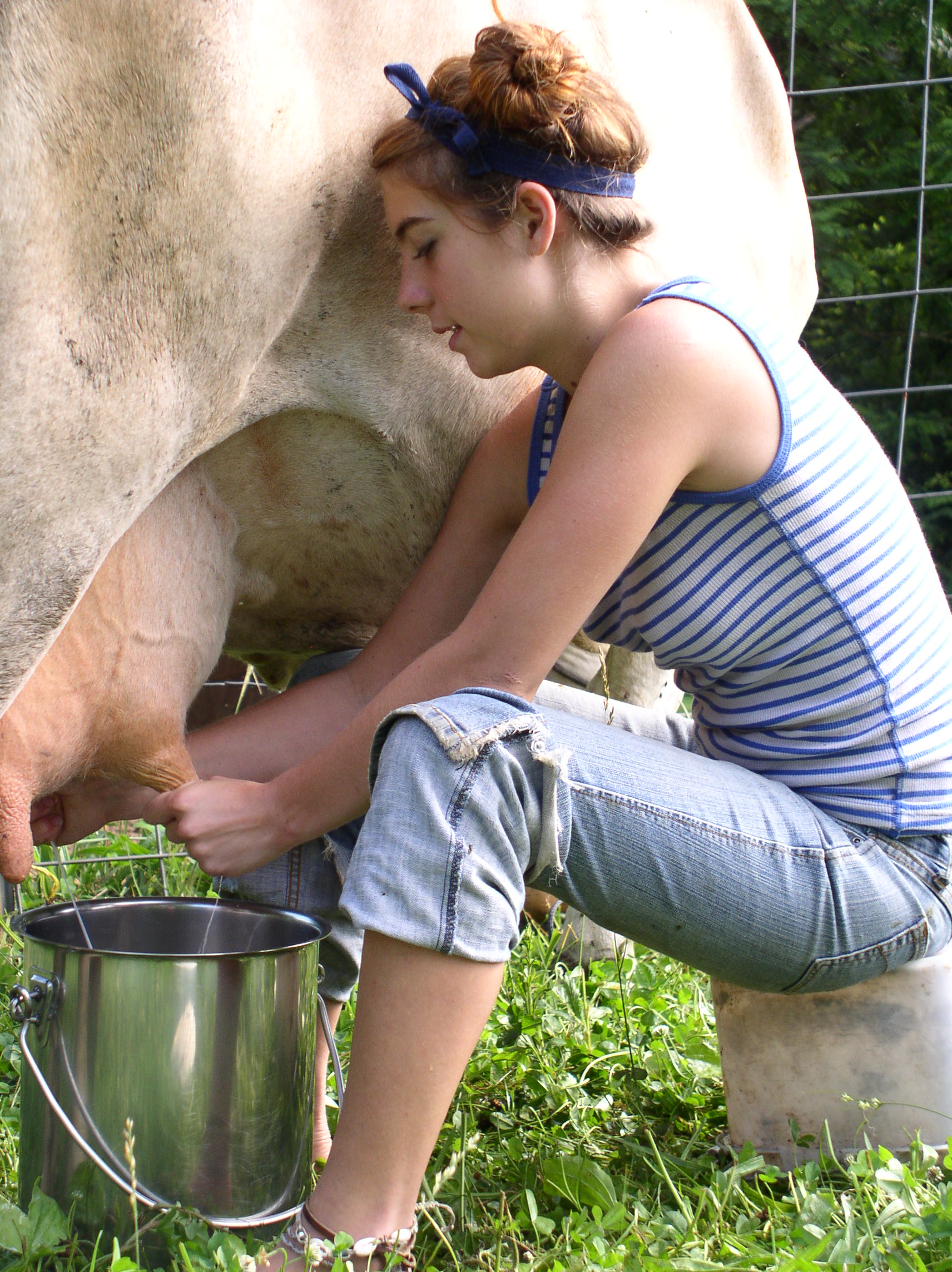
Friends, if you buy an animal keeping all these things in mind, then you will definitely choose a good milking animal.
Types of Cow
1. Gir
Daily milk average: 10 to 15 litre
Cost: 30,000 to 40,000 INR
Other names: Bhodali, Desan, Gujarati, Kathiawari, Sorthi, and Surati
The breeding tract of the breed includesSaurashtra region of Gujarat.The Gir or Gyr is one of the principal Zebu breeds originating in India. The Gir cattle are very gregarious and form a very close circle at night with their calves sleeping under their heads.The Gir or Gyr is one of the principal Zebu breeds originating in India. It has been used locally in the improvement of other breeds including the Red Sindhi and the Sahiwal.
It was also one of the breeds used in the development of the Brahman breed in North America. In Brazil and other South American countries the Gir is used frequently because, as a Bos indicus breed, it is resistant to hot temperatures and tropical diseases.
According to the latest reports, science says that A2 milk is consisting of the best combination of Omega fats is good for human health and the Indian breed cows are giving the best quality A2 milk for human consumption. Gir cow breed from India is highly reputed for A2 milk.
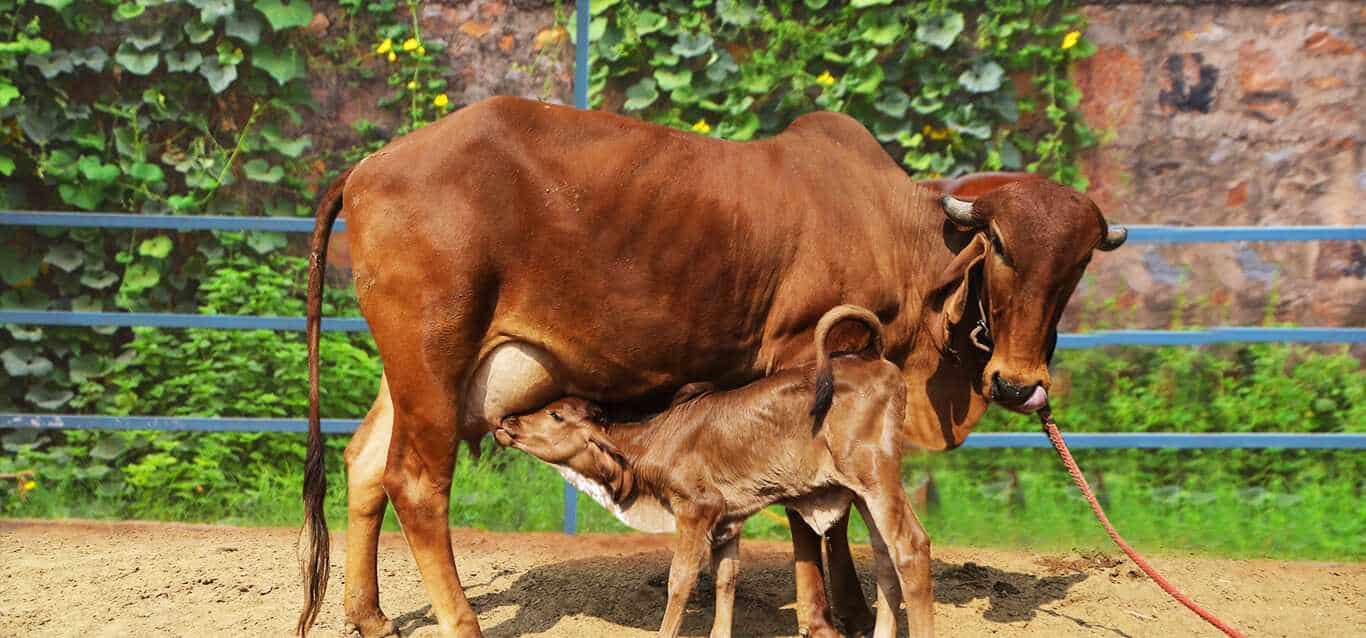
2. Red Sindhi
Daily milk average: 10 to 15 litre
Cost: 50,000 to 70,000 INR
Other names: Malir, Red Karachi and Sindhi
It is believed that the breed evolved from Las Bela cattle of Bela, Balochistan.This breed has been imported by more than 20 countries.The breed was originated in Hyderabad, Pakistan and Bikaner, India. The breed has been used for crossbreeding with temperate origin dairy cattle breeds in many countries to combine their tropical adaptations (heat tolerance, tick resistance, disease resistance, fertility at higher temperatures, etc.) with the higher milk production found in temperate regions.
The Red Sindhi cattle are medium sized animals, and they are very beautiful in appearance. They range in color from a deep reddish brown to a yellowish red, but most commonly deep red. The bulls are generally of a darker color than the cows.The Red Sindhi cattle are raised mainly as a dairy cattle breed in India. But in other countries, it is also raised for meat.The Red Sindhi cattle are very hardy and strong animals. They are well adapted to their local climates, and also do well in some other environment. That’s why, today they are widely available throughout the world.

3. Sahiwal
Daily milk average: 10 to 15 litre
Cost: 65,000 to 80,000 INR
Other names: mint kumre
Sahiwal cattle are a breed of zebu cow, named after an area in the Punjab, Pakistan.The cattle is mainly found in Punjab province of Pakistan, and Indian states of Punjab, Haryana, & Rajasthan. Sahiwal is considered a heat-tolerant cattle breed.The Sahiwal was exported to Australia via New Guinea in the early 1950’s. In Australia, the Sahiwal was initially selected as a dual-purpose breed. It is the most promising breed, producing the most milk, followed by the Red Sindhi and Butana varieties, which are extremely similar.
Dewlap is medium in size. Average lactation yield of Sahiwal cows is 2325 kilo grams. The lactation yield ranges from 1600 to 2750 Kg. However, selected herds may have higher productivity. Milk yield as high as 6000 lit has been recorded under organized farm conditions.
Only the Sahiwal breed has allele A2, which included proline rather than the histidine protein seen in other breeds' milk. Because of the presence of this additional allele, Sahiwal's milk is a godsend to humanity, as it aids in the treatment of ailments such as cholesterol, diabetes, and heart disease.

4. Jersey
Use: dairy; draught
Daily milk average : 8-10 liter per day.
Distribution: world-wide
Mass: 540 – 820 kg (Adult), 400 – 500 kg (Adult)
Lifespan : 25 years or more
The Jersey adapts well to various climates and environments, and unlike many breeds originating in temperate climates, these cows can tolerate heat very well. It has been exported to many countries of the world; in some of them, including Denmark, France, New Zealand, and the United States, it has developed into an independent breed.In Nepal, it is used as a draught animal.
Jerseys occur in all shades of brown, from light tan to almost black. They are frequently fawn in colour. All purebred Jerseys have a lighter band around their muzzles, a dark switch (long hair on the end of the tail), and black hooves.Brown Bessie, the famous champion butter cow of the Chicago World's Fair dairy test, averaged over 18 kg (40 lb) of milk a day for five months, and made 1.3 kg (3 lb) of butter a day.Scientific studies also show the Jersey cow produces milk more efficiently than other breeds. This can be especially important in countries where feed may be restricted. As well as making the Jersey a profitable option in agriculturally developed countries.
Characteristics : It is typically light brown in colour, though this can range from being almost grey to dull black, which is known as Mulberry. They can also have white patches which may cover much of the animal. A true Jersey will however always have a black nose bordered by an almost white muzzle.

5.Rathi
Daily milk avarege : 7-10 liters of milk
The Rathi cattle are an important breed of cattle indigenous to India. It is a milk cattle breed and primarily used for milk production and for draft purposes. Rathi cattle are a Bos indicus breed originated from Bikaner, Ganganagar and Hanumangarh districts in northwest Rajasthan, India.It is well suited for hotter regions of India. Places in Karnataka like Bellary , Gulbarga , Davanagere , sanodoor, and many other places are suitable for this breed.
The Rathi is medium sized cattle withshort horn or absent horn, straight face, flat forehead, wide eyes, well developed fore and hind quarter, long naval flap. The Rathi cattle are usually brown in color with white patches all over the body. Although some cattle are found to be completely brown or black coat with white patches. The typical characteristics of Rathi cattle is that it easily acclimatized with widerange of climatic condition like chilly winter (20C) to hot summer (500C) and even withstand sand-storm.
Rathi cattle are thought to have evolved from intermixing of Sahiwal, Red Sindhi, Tharparkar and Dhanni breeds with a preponderance of Sahiwal blood. Rathi cows are efficient and good milkers. The cows on an average produce 1560 kilo grams of milk. The lactation milk yield ranges from 1062 to 2810 Kg.
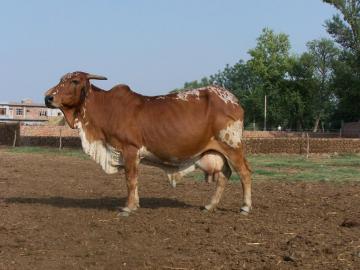
6. Deoni
Use: dual-purpose: draught, milk
Daily milk average: 10 to 15 liters
Cost: 32,000 to 65,000 INR
Other name: Dongerpati, Dongari, Wannera, Waghyd, Balankya, Shevera.
Deoni is a draught type animal believed to be developed from a strain descended from the mixture of Gir, Dangi and local cattle. The breed developed its name from the place of origin i.e. Deoni taluk of Latur district in Maharashtra.The Deoni cattle is found in three color variations. These variations are; white body with irregular black spots (Shevera), clear white with black color at the sides of the face (Wannera) and clear white with black spots on the lower side of the body (Balankya). Their skin is thick and loosely attached to the body.
The breed is characterized by drooping ears and prominent & slightly bulging forehead. Deoni bullocks are preferred for heavy works and bullocks can effectively be used even up to 12 years of age. Animals are maintained on semi-intensive management system and on grazing. The average milk yield per lactation of Deoni is 868 kg (ranging between 638 to 1229 kg) with an average milk fat is 4.3 (ranges from 2.5 to 5.3 %).
On average Deoni cow produces around 2-3 kg milk per day on crop residues whereas higher milk-producing herds can be found in institutional herds maintained on balanced feed. The average lactation yield is 400 -600 kg with a fat percentage of around 4.5-5.5%. Age at first calving under field conditions is 37-42 months with an inter-calving period of around 16-18 months.

Other types of Cow
Cow name with A
|
Breed |
Image |
Country/region of origin |
Meat |
Dairy |
|---|---|---|---|---|
|
Aberdeen Angus |
Scotland |
Meat |
Dairy |
|
|
Abergele |
Ethiopia |
Meat |
Dairy |
|
|
Abigar |
|
Ethiopia |
— |
Dairy |
|
Abondance |
France |
Meat |
Dairy |
|
|
Abyssinian Shorthorned Zebu |
|
Ethiopia |
— |
— |
|
Aceh |
— |
Indonesia |
Meat |
— |
|
Achham |
|
Nepal |
— |
Dairy |
|
Adamawa |
|
Nigeria |
Meat |
Dairy |
|
Adaptaur |
Australia |
Meat |
— |
|
|
Afar |
|
Ethiopia |
Meat |
Dairy |
|
Africangus |
|
South Africa |
Meat |
— |
|
Afrikaner |
South Africa |
Meat |
— |
|
|
Agerolese |
|
Italy |
— |
Dairy |
|
Alambadi |
|
India |
— |
— |
|
Alatau |
|
Kazakhstan |
Meat |
Dairy |
|
Albanian |
|
Albania |
— |
Dairy |
|
Albera |
Spain, France |
Meat |
— |
|
|
Alderney |
Channel Islands |
— |
Dairy |
|
|
Alentejana |
Portugal |
Meat |
— |
|
|
Aleutian wild cattle |
|
United States |
— |
— |
|
Aliad Dinka |
|
South Sudan |
— |
— |
|
Alistana-Sanabresa |
|
Spain |
— |
— |
|
Allmogekor |
|
Sweden |
Meat |
— |
|
Alur |
|
Democratic Republic of the Congo |
— |
— |
|
American |
|
United States |
Meat |
— |
|
American Angus |
|
United States |
— |
— |
|
American Beef Friesian |
|
United States |
— |
— |
|
American Brown Swiss |
|
United States |
— |
Dairy |
|
American Milking Devon |
United States |
Meat |
Dairy |
|
|
American White Park |
|
United States |
Meat |
Dairy |
|
Amerifax |
|
United States |
Meat |
Dairy |
|
Amrit Mahal |
India |
— |
— |
|
|
Amsterdam Island cattle |
Amsterdam Island |
— |
— |
|
|
Anatolian Black |
Turkey |
Meat |
Dairy |
|
|
Andalusian Black |
|
Spain |
Meat |
— |
|
Andalusian Blond |
|
Spain |
— |
— |
|
Andalusian Grey |
|
Spain |
— |
— |
|
Angeln |
|
Germany |
— |
Dairy |
|
Angoni |
|
Malawi |
— |
— |
|
Ankina |
|
United States |
— |
— |
|
Ankole |
East Africa |
meat |
dairy |
|
|
Ankole-Watusi |
United States |
|
|
|
|
Aracena |
|
Spain |
— |
— |
|
Arado |
Ethiopia |
Meat |
Dairy |
|
|
Argentine Criollo |
Argentina |
Meat |
Dairy |
|
|
Argentine Friesian |
|
Argentina |
— |
Dairy |
|
Armorican |
France |
Meat |
Dairy |
|
|
Arouquesa |
Portugal |
Meat |
Dairy |
|
|
Arsi |
|
Ethiopia |
— |
— |
|
Asturian Mountain |
Spain |
Meat |
Dairy |
|
|
Asturian Valley |
Spain |
Meat |
Dairy |
|
|
Aubrac |
France |
Meat |
Dairy |
|
|
Aulie-Ata |
|
Kazakhstan |
— |
Dairy |
|
Aure et Saint-Girons |
France |
Meat |
Dairy |
|
|
Australian Braford |
Australia |
Meat |
— |
|
|
Australian Brangus |
Australia |
Meat |
— |
|
|
Australian Charbray |
|
Australia |
Meat |
— |
|
Australian Friesian Sahiwal |
Australia |
— |
Dairy |
|
|
Australian Lowline |
Australia |
Meat |
— |
|
|
Australian Milking Zebu |
Australia |
— |
Dairy |
|
|
Australian Shorthorn |
|
Australia |
Meat |
— |
|
Austrian Simmental |
|
Austria |
— |
— |
|
Austrian Yellow |
|
Austria |
— |
— |
|
Avétonou |
|
Togo |
— |
— |
|
Avileña-Negra Ibérica |
Spain |
— |
— |
|
|
Aweil Dinka |
|
South Sudan |
— |
— |
|
Ayrshire |
Scotland |
— |
Dairy |
|
|
Azaouak |
|
Mali |
— |
— |
|
Azebuado |
|
Brazil |
— |
— |
|
Azerbaijan Zebu |
|
Azerbaijan |
— |
— |
|
Azores |
|
Portugal |
— |
— |
Cow name with B
|
Breed |
Image |
Country/region of origin |
Meat |
Dairy |
|---|---|---|---|---|
|
Bachaur cattle |
|
India |
— |
Dairy |
|
Baherie cattle |
|
Eritrea |
Meat |
Dairy |
|
Bakosi cattle |
|
Cameroon |
Meat |
— |
|
Balancer |
|
United States |
Meat |
Dairy |
|
Baoule |
|
Ivory Coast |
— |
Dairy |
|
Bargur cattle |
India |
— |
Dairy |
|
|
Barrosã |
Portugal |
Meat |
— |
|
|
Barzona |
|
United States |
Meat |
— |
|
Bazadaise |
France |
Meat |
— |
|
|
Beef Freisian |
|
United States |
Meat |
Dairy |
|
Beefalo |
United States |
Meat |
— |
|
|
Beefmaker |
|
United States |
Meat |
— |
|
Beefmaster |
|
United States |
Meat |
— |
|
Begayt |
|
Ethiopia |
Meat |
Dairy |
|
Belgian Blue |
Belgium |
Meat |
Dairy |
|
|
Belgian Red |
Belgium, France |
Meat |
Dairy |
|
|
Belgian Red Pied |
|
Belgium |
Meat |
Dairy |
|
Belgian White-and-Red |
Belgium |
Meat |
Dairy |
|
|
Belmont Red |
Australia |
Meat |
— |
|
|
Belted Galloway |
Scotland |
Dairy |
— |
|
|
Bernese |
|
Switzerland |
— |
— |
|
Berrenda cattle |
Spain |
Meat |
Dairy |
|
|
Betizu |
Spain, France |
Meat |
— |
|
|
Bianca Modenese |
|
Italy |
Meat |
Dairy |
|
Blaarkop |
Netherlands |
Meat |
Dairy |
|
|
Black Baldy |
Australia |
Meat |
— |
|
|
Black Hereford |
England |
Meat |
— |
|
|
Blanca Cacereña |
|
Spain |
Meat |
Dairy |
|
Blanco Orejinegro BON |
|
Colombia |
Meat |
Dairy |
|
Blonde d'Aquitaine |
France |
Meat |
Dairy |
|
|
Blue Albion |
|
Great Britain |
Meat |
— |
|
Blue Grey |
Great Britain |
Meat |
— |
|
|
Bohuskulla |
|
Sweden |
— |
— |
|
Bonsmara |
South Africa |
Meat |
— |
|
|
Boran |
eastern Africa |
Meat |
— |
|
|
Boškarin |
Croatia, Slovenia |
Meat |
Dairy |
|
|
Braford |
|
United States |
Meat |
— |
|
Brahman |
India |
Meat |
Dairy |
|
|
Brahmousin |
|
United States |
Meat |
— |
|
Brangus |
United States |
Meat |
— |
|
|
Braunvieh |
Switzerland |
Meat |
Dairy |
|
|
Brava |
|
Spain |
— |
— |
|
Bretonne Pie Noir |
France |
— |
Dairy |
|
|
British White |
Great Britain |
Meat |
Dairy |
|
|
British Friesian |
Great Britain |
— |
Dairy |
|
|
Brown Carpathian |
|
Ukraine |
— |
— |
|
Brown Caucasian |
Armenia |
Meat |
Dairy |
|
|
Brown Swiss |
Switzerland |
— |
Dairy |
|
|
Bue Lingo |
|
United States |
Meat |
Dairy |
|
Burlina |
|
Italy |
— |
Dairy |
|
Buša cattle |
former Yugoslavia - Bosnia and Herzegovina, Croatia, Kosovo, Montenegro, North Macedonia, Serbia (Dinaric Alps) |
Meat |
Dairy |
|
|
Butana cattle |
|
Sudan |
— |
Dairy |
|
Bushuyev |
|
Uzbekistan |
— |
Dairy |
Cow name with C
|
Breed |
Image |
Country/region of origin |
Meat |
Dairy |
|---|---|---|---|---|
|
Cachena |
Portugal/Spain |
Meat |
Dairy |
|
|
Caldelana |
|
Spain |
Meat |
Dairy |
|
Camargue |
France |
Meat |
— |
|
|
Campbell Island cattle |
|
New Zealand |
— |
— |
|
Canadian Speckle Park |
Canada |
Meat |
— |
|
|
Canadienne |
Canada |
Meat |
Dairy |
|
|
Canaria |
|
Spain |
Meat |
— |
|
Canchim |
Brazil |
Meat |
— |
|
|
Caracu |
Brazil |
Meat |
Dairy |
|
|
Cárdena Andaluza |
|
Spain |
Meat |
— |
|
Carinthian Blondvieh |
Austria |
Meat |
Dairy |
|
|
Carora |
|
Venezuelan |
Meat |
Dairy |
|
Charbray |
|
United States |
Meat |
— |
|
Charolais |
France |
Meat |
— |
|
|
Chateaubriand |
|
— |
— |
— |
|
Chiangus |
|
— |
Meat |
— |
|
Chianina |
Italy |
Meat |
— |
|
|
Chillingham cattle |
England |
— |
— |
|
|
Chinese Black Pied |
|
China |
— |
Dairy |
|
Cholistani |
|
Pakistan |
— |
Dairy |
|
Cika cattle |
Slovenia |
Meat |
Dairy |
|
|
Coloursided White Back |
|
— |
Meat |
Dairy |
|
Commercial |
|
— |
— |
— |
|
Corriente |
Spain |
Meat |
Dairy |
|
|
Corsican cattle |
France |
Meat |
— |
|
|
Costeño con Cuernos |
|
Colombia |
Meat |
— |
|
Crioulo Lageano |
|
— |
— |
— |
Cow name with D
|
Breed |
Image |
Country/region of origin |
Meat |
Dairy |
|---|---|---|---|---|
|
Dajal |
|
Pakistan |
Meat |
Dairy |
|
Dangi cattle |
India |
— |
— |
|
|
Danish Black-Pied |
|
Denmark |
— |
— |
|
Danish Jersey |
|
Denmark |
— |
Dairy |
|
Danish Red |
Denmark |
Meat |
Dairy |
|
|
Deep Red cattle |
|
— |
Meat |
Dairy |
|
Deoni |
India |
— |
Dairy |
|
|
Devon |
England |
Meat |
Dairy |
|
|
Dexter cattle |
Ireland |
Meat |
Dairy |
|
|
Dhanni |
Pakistan |
Meat |
Dairy |
|
|
Doayo cattle |
|
Cameroon |
— |
— |
|
Doela |
|
— |
— |
— |
|
Drakensberger |
|
South Africa |
Meat |
Dairy |
|
Dølafe |
Norway |
Meat |
Dairy |
|
|
Droughtmaster |
Australia |
Meat |
— |
|
|
Dulong' |
|
— |
Meat |
— |
|
Dutch Belted |
Netherlands |
Meat |
Dairy |
|
|
Dutch Friesian |
|
Netherlands |
Meat |
Dairy |
|
Dwarf Lulu |
|
— |
— |
— |
Cow name with E
|
Breed |
Image |
Country/region of origin |
Meat |
Dairy |
|---|---|---|---|---|
|
East Anatolian Red |
|
— |
— |
Dairy |
|
Eastern Finncattle |
Finland |
Meat |
Dairy |
|
|
Eastern Red Polled |
|
— |
— |
— |
|
Enderby Island cattle |
|
New Zealand |
— |
— |
|
English Longhorn |
England |
Meat |
Dairy |
|
|
Ennstaler Bergscheck |
Austria |
Meat |
— |
|
|
Estonian Holstein |
|
Estonia |
— |
Dairy |
|
Estonian Native |
|
Estonia |
— |
— |
|
Estonian Red cattle |
|
Estonia |
Meat |
Dairy |
|
Évolène cattle |
Switzerland |
— |
Dairy |
Cow name with F
|
Breed |
Image |
Country/region of origin |
Meat |
Dairy |
|---|---|---|---|---|
|
Fēng Cattle |
|
China |
Meat |
Diary |
|
Finnish Ayrshire |
Finland |
— |
— |
|
|
Finncattle |
Finland |
Meat |
Dairy |
|
|
Finnish Holstein-Friesian |
|
Finland |
— |
— |
|
Fjäll |
Sweden |
Meat |
Dairy |
|
|
Fleckvieh |
Austria |
Meat |
Dairy |
|
|
Florida Cracker cattle |
United States |
Meat |
— |
|
|
Fogera |
|
Ethiopia |
Meat |
Dairy |
|
French Simmental |
France |
Meat |
Dairy |
|
|
Fribourgeoise |
|
Switzerland |
— |
— |
|
Friesian Red and White |
|
— |
Meat |
Dairy |
|
Fulani Sudanese |
|
— |
Meat |
Dairy |
Cow name with G
|
Breed |
Image |
Country/region of origin |
Meat |
Dairy |
|---|---|---|---|---|
|
Galician Blond |
Spain |
Meat |
Dairy |
|
|
Galloway cattle |
Scotland |
Meat |
Dairy |
|
|
Gangatiri |
India |
— |
Dairy |
|
|
Gaolao |
India |
— |
Dairy |
|
|
Garvonesa |
|
Portugal |
Meat |
— |
|
Gascon cattle |
France |
Meat |
— |
|
|
Gelbvieh |
Germany |
Meat |
Dairy |
|
|
Georgian Mountain cattle |
|
Georgia |
Meat |
Dairy |
|
German Angus |
Germany |
Meat |
— |
|
|
German Black Pied cattle |
Germany |
— |
Dairy |
|
|
German Black Pied Dairy |
|
Germany |
— |
Dairy |
|
German Red Pied |
|
Germany |
Meat |
Dairy |
|
Gir |
India |
— |
Dairy |
|
|
Glamorgan cattle |
England |
Meat |
Dairy |
|
|
Glan cattle |
Germany |
Meat |
Dairy |
|
|
Gloucester |
England |
Meat |
Dairy |
|
|
Gobra |
|
— |
Meat |
— |
|
Greek Shorthorn |
|
Greece |
Meat |
Dairy |
|
Greek Steppe |
|
Greece |
Meat |
Dairy |
|
Greyman cattle |
Australia |
Meat |
— |
|
|
Gudali |
|
Iran/Persia |
— |
Dairy |
|
Guernsey cattle |
Channel Islands |
— |
Dairy |
|
|
Guzerá |
Brazil |
Meat |
— |
Cow name with H
|
Breed |
Image |
Country/region of origin |
Meat |
Dairy |
|---|---|---|---|---|
|
Hallikar |
India |
|
— |
|
|
Hanwoo |
Korea |
Meat |
— |
|
|
Hariana cattle |
India |
— |
Dairy |
|
|
Hartón del Valle |
|
Colombia |
Meat |
Dairy |
|
Harzer Rotvieh |
Germany |
Meat |
Dairy |
|
|
Hays Converter |
|
Canada |
Meat |
— |
|
Heck cattle |
|
Germany |
— |
— |
|
Hereford |
England |
Meat |
— |
|
|
Herens |
Switzerland, Italy, France |
Meat |
— |
|
|
Hybridmaster |
|
— |
Meat |
Dairy |
|
Highland cattle |
Scotland |
Meat |
— |
|
|
Hinterwald |
Germany |
Meat |
Dairy |
|
|
Holando-Argentino |
|
Argentina |
Meat |
Dairy |
|
Holstein Friesian cattle |
Germany, the Netherlands |
Meat |
Dairy |
|
|
Horro |
|
Ethiopia |
Meat |
— |
|
Huáng Cattle |
|
China |
Meat |
Dairy |
|
Hungarian Grey |
Hungary |
Meat |
— |
Cow name with I
Cow name with J
Cow name with K
Cow name with L
Cow name with M
Cow name with N
Cow name with O
| Breed | Image | Country/region of origin | Meat | Dairy |
|---|---|---|---|---|
| Ongole |  |
India | Meat | Dairy |
| Original Simmental | Switzerland | Meat | Dairy |
Cow name with P
Cow name with Q
| Breed | Image | Country/region of origin | Meat | Dairy |
|---|---|---|---|---|
| Qinchaun | China | Meat | — | |
| Queensland Miniature Boran | — | Meat | — |
Cow name with R
Cow name with S
Cow name with T
Cow name with U
| Breed | Image | Country/region of origin | Meat | Dairy |
|---|---|---|---|---|
| Umblachery |  |
India | — | Dairy |
| Ukrainian Grey | Ukraine | — | — |
Cow name with V
Cow name with W
Cow name with X
| Breed | Image | Country/region of origin | Meat | Dairy |
|---|---|---|---|---|
| Xingjiang Brown | — | Meat | Dairy |
Cow name with Y
| Breed | Image | Country/region of origin | Meat | Dairy |
|---|---|---|---|---|
| Yakutian |  |
Russia | Meat | Dairy |
| Yanbian | China | — | — | |
| Yanhuang | China | |||
| Yurino | Ukraine | — | — |
Cow name with Z
| Breed | Image | Country/region of origin | Meat | Dairy |
|---|---|---|---|---|
| Żubroń |  |
Poland | Meat | — |
| Zebu | — | Meat | Dairy |
This table credit goes to Wikipedia animals
Blog Upload on - Jan. 29, 2022
Views - 6090







































































































































































































































